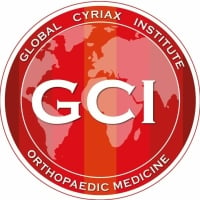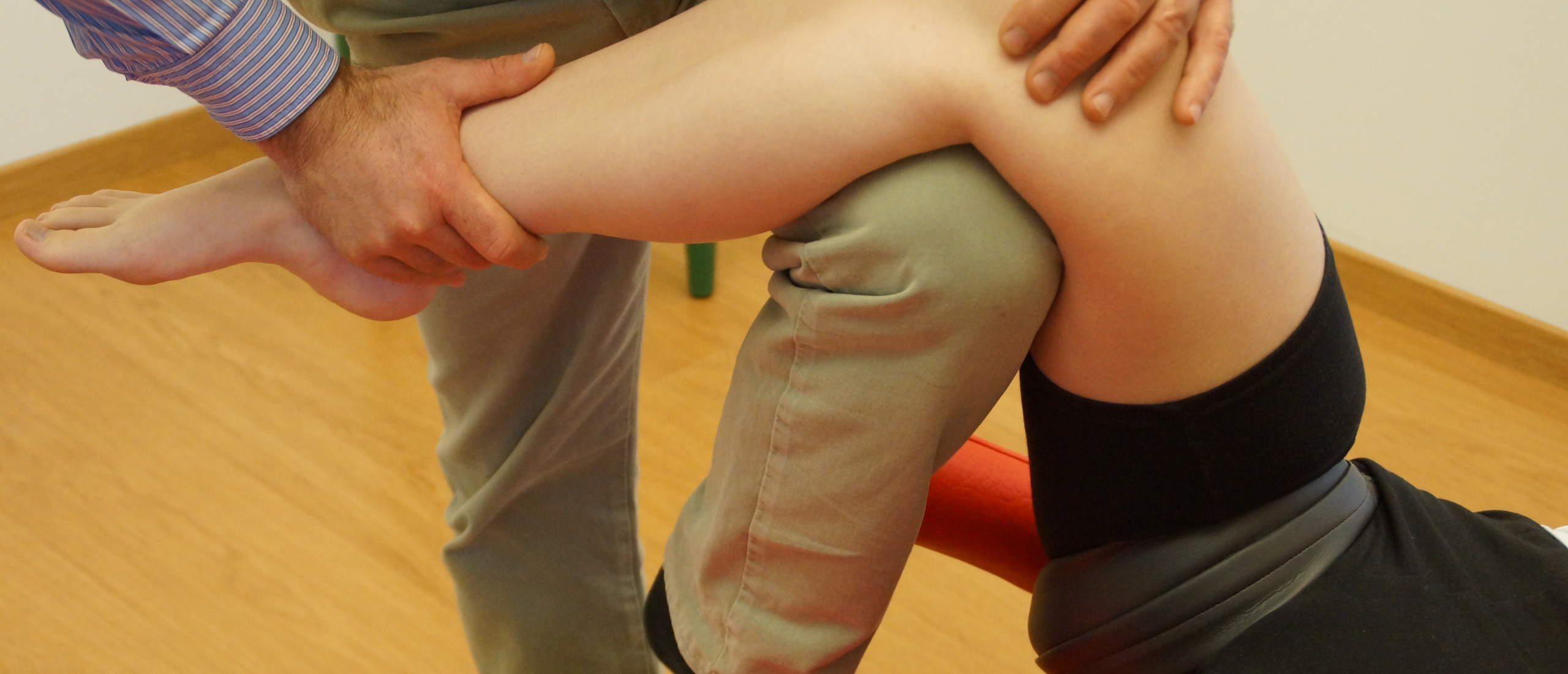
Loose bodies in the hip, and other articular lesions
An overview of some articular lesions in the hip
Osteoarthrosis
The capsular pattern at the hip, as originally described by Dr. Cyriax, is a normal range of lateral rotation and adduction, with limitation in the other directions. Medial rotation and abduction are the most limited movements, flexion is more limited than extension.
However, in more recent literature there seems to be some controversy on the validity of this capsular pattern.
The key elements are a limited medial rotation and flexion, while other movements are less limited.
The clinical pattern of osteoarthrosis is a (modified) capsular pattern with a hardened end-feel.
Sometimes there is no direct relation between medical imaging and the intensity of the symptoms : one can have marked degeneration, visible on medical imaging, without hardly any symptoms.
However, negative medical imaging does not exclude other pathology. Always keep in mind it is often more interesting to focus on clinical patterns instead of medical imaging only.
It is functionally important to maintain the best possible range of hip extension, in order to avoid putting too much strain on the lumbar spine.
Treatment
If the osteoarthrosis is not too advanced, capsular stretching is highly recommended ; the pain at night and the pain on walking quickly improve considerably. The range of movement, however, does not change appreciably.
The capsule is stretched mainly in three directions : flexion, extension and medial rotation ; (it can also be stretched towards abduction). A treatment session consists always of a combination of these three (four) techniques.
Keep in mind that an efficient intensity of capsular stretch produces an hour or two after pain. We need to adapt the intensity of the stretch accordingly.
Of course the patient is advised to also do some home exercises.
Capsular stretching in flexion
One hand immobilizes the other leg and hip flexion is built in, using our body weight through the other hand. The capsule is stretched for 45-60 seconds, either intermittently or sustained.
 capsular stretching in flexion
capsular stretching in flexion
Capsular stretching in extension
One hand on the upper femur, the other hand just above the knee. The capsule is stretched by using our body weight.
Alternative : the patient’s thigh rests upon the therapist’s thigh. In this way it is easier for the therapist to perform the procedure.
Remark : we should avoid too much knee flexion.
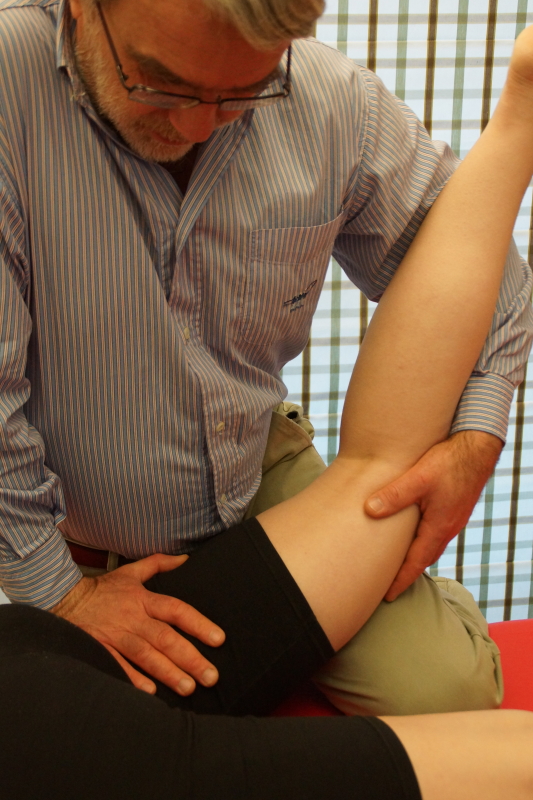 capsular stretching in extension
capsular stretching in extension
Capsular stretching in medial rotation
One hand stabilizes the pelvis at the same side, the other hand grasps just above the ankle. With this lever, the capsule is stretched in medial rotation.
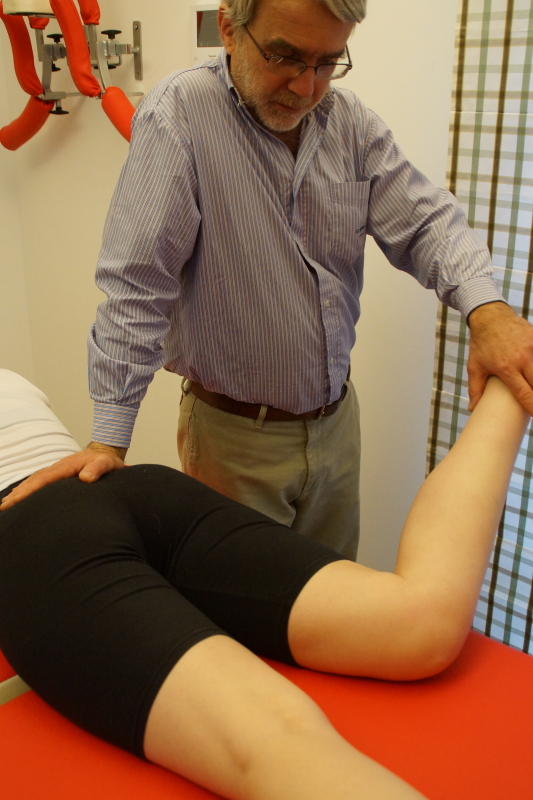 capsular stretching in medial rotation
capsular stretching in medial rotation
If the osteoarthrosis is too advanced for capsular stretching (e.g. end-feel on passive movement testing is too hard) and while awaiting surgery, other options could be:
- the desensitization of the posterior capsule (infiltration of 50 cc procaine, 0.5 %). The improvement lasts a few months and the infiltration can be repeated as often as needed, until surgery is called for.
- Or, repeated injections of hyaluronic acid can also offer temporary relief.
Loose body with osteoarthrosis
This disorder is not so rare, but the diagnosis is seldom made since the fragment(s), if they are not bony fragments, do not show on medical imaging. Mostly the patient receives the “arthrosis-verdict”.
The patient describes a typical internal derangement story:
- intermittent twinges felt in the front of the thigh and
- giving way of the limb.
During an acute phase, the capsular pattern of osteoarthrosis becomes non-capsular : passive flexion is now more limited than usual and we don’t reach the hard end feel anymore which was typical for the arthrotic joint.
Possibly, passive lateral rotation now hurts more than medial rotation.
If the loose body is not bony, then manipulation offers immediate relief of symptoms.
If loose bodies are bony, surgery is called for.
Treatment
Loose body manipulation
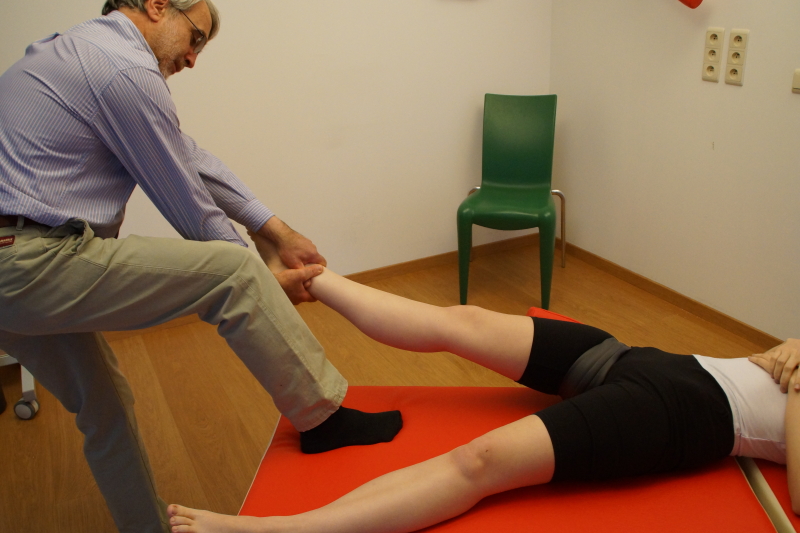 Hip loose body manipulation
Hip loose body manipulation
The patient’s pelvis is stabilized by an assistant or by a strap. The therapist stands on the end of the couch, grasps the patient’s ankle and holds his limb in about 80° straight-leg raise. With a grip that avoids movement in the foot he uses his body weight for applying traction in this 80° direction ; he maintains this traction while gradually stepping off the couch backwards. In the meantime, he performs three full rotations (medial or lateral).
Grip for medial rotation : the therapist faces inwards. His distal hand grasps the outer malleolus, the proximal hand supports and stabilizes the grip.
Grip for lateral rotation : the therapist faces outwards. His distal hand grasps the inner malleolus, the proximal hand supports and stabilizes the grip.
Loose body, manipulation, medial rotation or lateral rotation
The patient’s pelvis is stabilized by an assistant or by a strap. For a right hip, the manoeuvre is as follows : the therapist puts his left foot on the couch, by means of an abduction movement his thigh is put under the patient’s knee (comfortably, i.e. not under the calf). Now, the patient’s knee is bent, the assistant stabilizes the pelvis and the therapist half plantiflexes his foot. He leans sideways to increase the traction component, maintains the knee flexion while reaching the end of medial or lateral rotation.
The manipulation consists of a high velocity-low amplitude jerk towards rotation, combined with the second half of plantiflexion at his foot.
 Hip loose body manipulation (alternative)
Hip loose body manipulation (alternative)
Grip for medial rotation : one hand on the outer part of the knee and one hand medially above the foot.
Grip for lateral rotation : one hand on the inner part of the knee and one hand laterally above the foot.
Remark : a technical problem may arise when the therapist, compared to the patient, is either too tall or too short. In the former case, he uses his leg obliquely instead of vertically, in the latter case he needs a sort of platform under his foot.
Rheumatoid arthritis
There is considerable aching in the thigh on exertion ; the examination shows a slight capsular pattern. A treatment option consists of e.g. an i.a. injection of triamcinolone.
Remark : the injection should not be given more frequently than once every six months, for fear of provoking steroid arthropathy.
Spondylitic arthritis (Bechterew)
After the sacroiliac joints and the spine, the hip joints may become affected. Gentle capsular stretching is indicated between the attacks.
Arthritis tends to produce morning stiffness and pain due to accumulation of intracapsular swelling overnight.
